Building and Construction: Timber Floor System Compliance Analysis
VerifiedAdded on 2022/10/10
|9
|1605
|40
Project
AI Summary
This project assesses the structural compliance of a timber floor system based on AS1684-2010 standards. The analysis includes interpreting data from provided drawings, performing calculations to check for compliance, and identifying any areas where the system does not meet the requirements. The document also provides a detailed sketch of the floor layout, including proposed changes to address non-compliance issues, and suggests an alternative bearer and joist system using engineered timber products to improve sustainability. Furthermore, the project examines the platform floor sheeting system, detailing the type of sheeting used (plywood) and the procedure for its layout and installation. The project also includes slenderness calculations and load checking to ensure the structural integrity of the floor system. The document concludes with recommendations for the construction process, ensuring compliance with Australian standards.
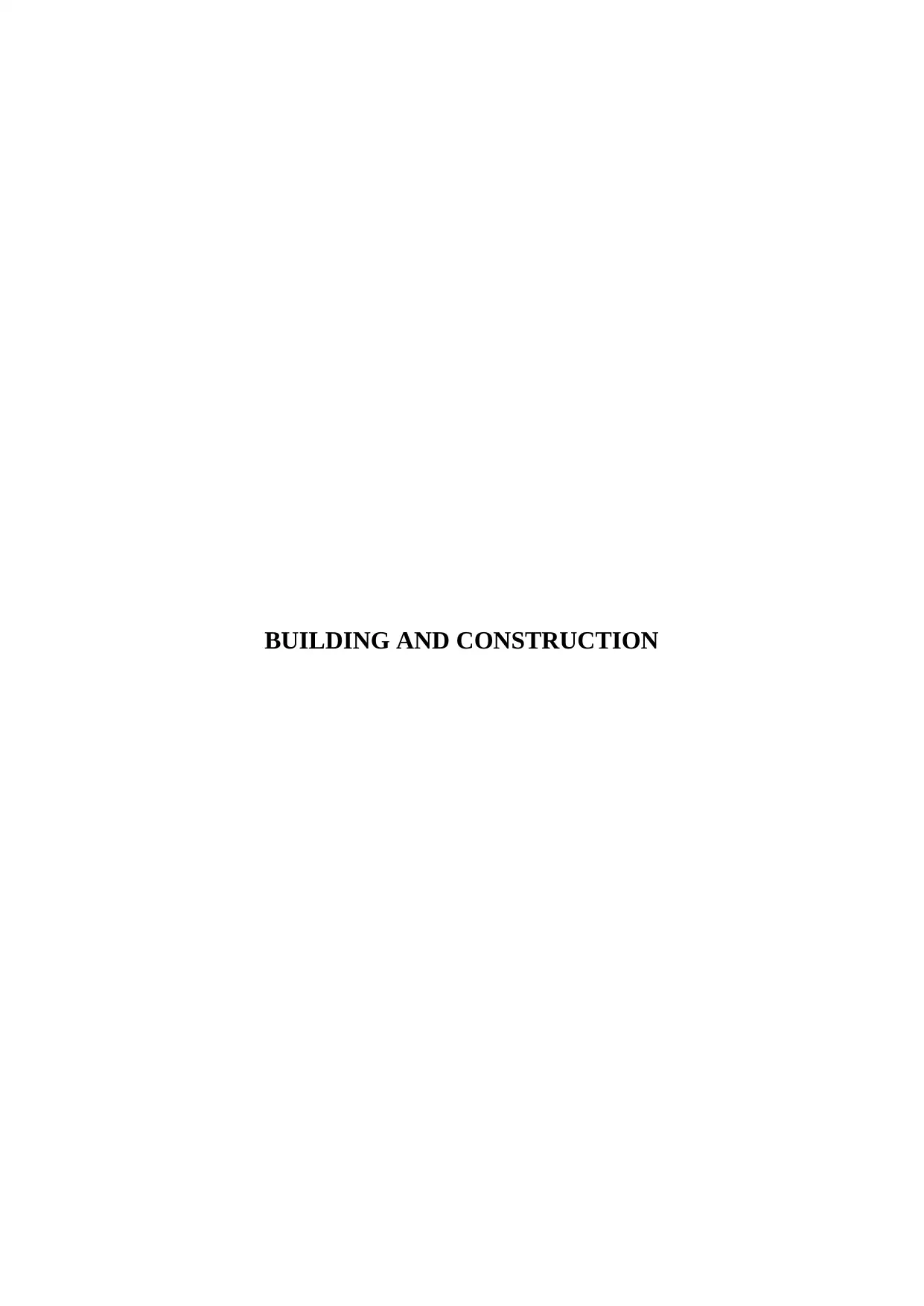
BUILDING AND CONSTRUCTION
Paraphrase This Document
Need a fresh take? Get an instant paraphrase of this document with our AI Paraphraser
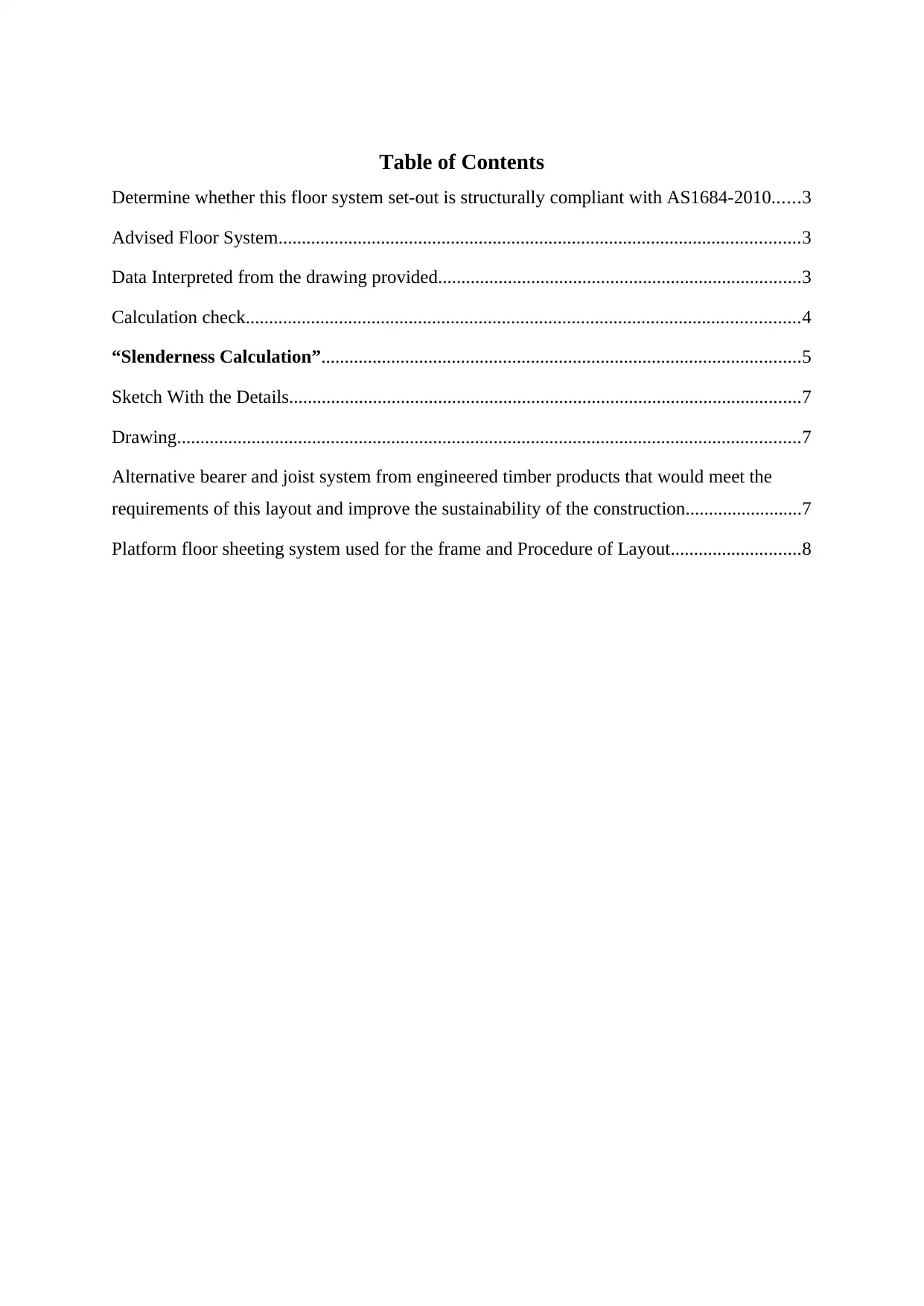
Table of Contents
Determine whether this floor system set-out is structurally compliant with AS1684-2010......3
Advised Floor System................................................................................................................3
Data Interpreted from the drawing provided..............................................................................3
Calculation check.......................................................................................................................4
“Slenderness Calculation”.......................................................................................................5
Sketch With the Details..............................................................................................................7
Drawing......................................................................................................................................7
Alternative bearer and joist system from engineered timber products that would meet the
requirements of this layout and improve the sustainability of the construction.........................7
Platform floor sheeting system used for the frame and Procedure of Layout............................8
Determine whether this floor system set-out is structurally compliant with AS1684-2010......3
Advised Floor System................................................................................................................3
Data Interpreted from the drawing provided..............................................................................3
Calculation check.......................................................................................................................4
“Slenderness Calculation”.......................................................................................................5
Sketch With the Details..............................................................................................................7
Drawing......................................................................................................................................7
Alternative bearer and joist system from engineered timber products that would meet the
requirements of this layout and improve the sustainability of the construction.........................7
Platform floor sheeting system used for the frame and Procedure of Layout............................8
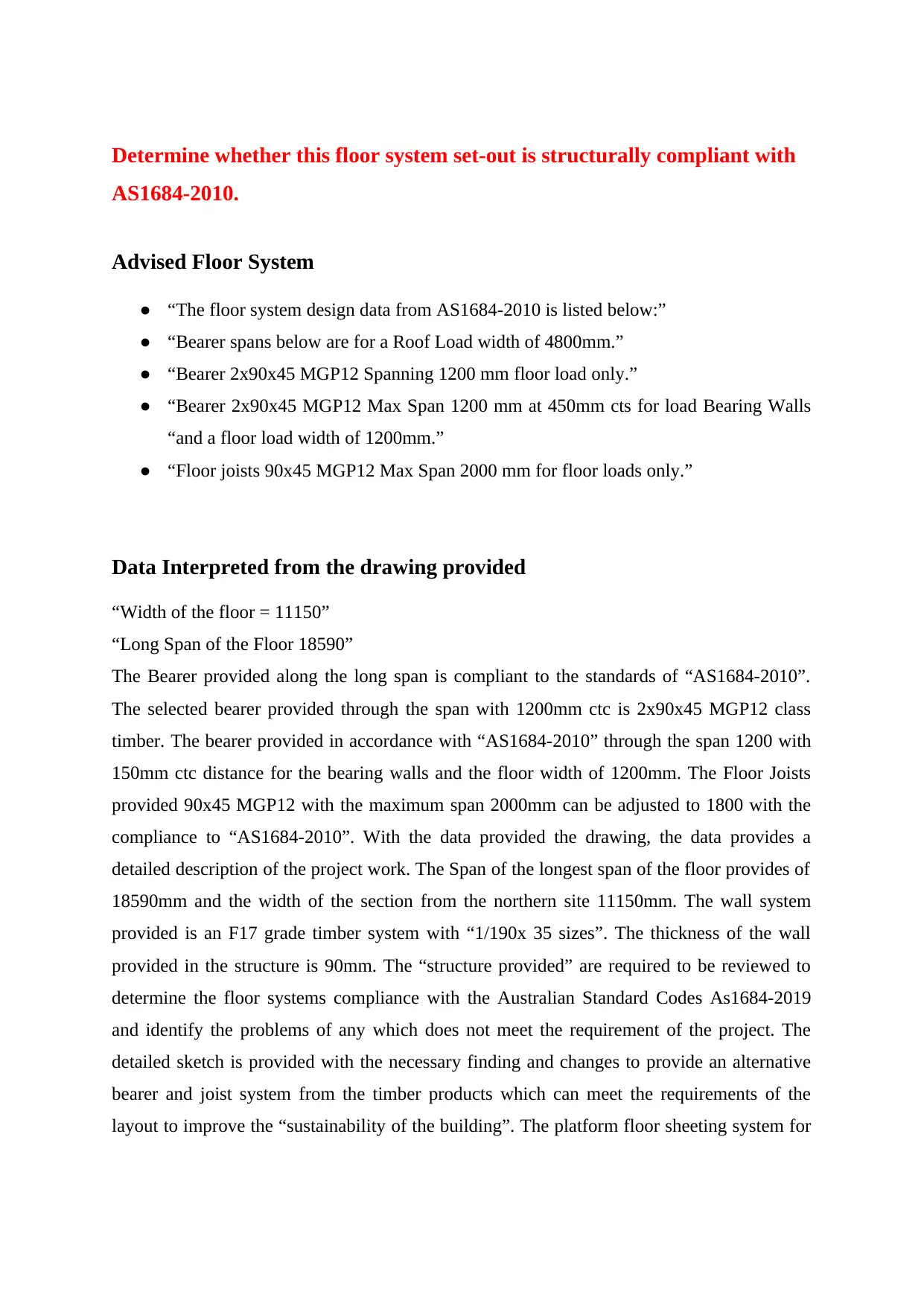
Determine whether this floor system set-out is structurally compliant with
AS1684-2010.
Advised Floor System
● “The floor system design data from AS1684-2010 is listed below:”
● “Bearer spans below are for a Roof Load width of 4800mm.”
● “Bearer 2x90x45 MGP12 Spanning 1200 mm floor load only.”
● “Bearer 2x90x45 MGP12 Max Span 1200 mm at 450mm cts for load Bearing Walls
“and a floor load width of 1200mm.”
● “Floor joists 90x45 MGP12 Max Span 2000 mm for floor loads only.”
Data Interpreted from the drawing provided
“Width of the floor = 11150”
“Long Span of the Floor 18590”
The Bearer provided along the long span is compliant to the standards of “AS1684-2010”.
The selected bearer provided through the span with 1200mm ctc is 2x90x45 MGP12 class
timber. The bearer provided in accordance with “AS1684-2010” through the span 1200 with
150mm ctc distance for the bearing walls and the floor width of 1200mm. The Floor Joists
provided 90x45 MGP12 with the maximum span 2000mm can be adjusted to 1800 with the
compliance to “AS1684-2010”. With the data provided the drawing, the data provides a
detailed description of the project work. The Span of the longest span of the floor provides of
18590mm and the width of the section from the northern site 11150mm. The wall system
provided is an F17 grade timber system with “1/190x 35 sizes”. The thickness of the wall
provided in the structure is 90mm. The “structure provided” are required to be reviewed to
determine the floor systems compliance with the Australian Standard Codes As1684-2019
and identify the problems of any which does not meet the requirement of the project. The
detailed sketch is provided with the necessary finding and changes to provide an alternative
bearer and joist system from the timber products which can meet the requirements of the
layout to improve the “sustainability of the building”. The platform floor sheeting system for
AS1684-2010.
Advised Floor System
● “The floor system design data from AS1684-2010 is listed below:”
● “Bearer spans below are for a Roof Load width of 4800mm.”
● “Bearer 2x90x45 MGP12 Spanning 1200 mm floor load only.”
● “Bearer 2x90x45 MGP12 Max Span 1200 mm at 450mm cts for load Bearing Walls
“and a floor load width of 1200mm.”
● “Floor joists 90x45 MGP12 Max Span 2000 mm for floor loads only.”
Data Interpreted from the drawing provided
“Width of the floor = 11150”
“Long Span of the Floor 18590”
The Bearer provided along the long span is compliant to the standards of “AS1684-2010”.
The selected bearer provided through the span with 1200mm ctc is 2x90x45 MGP12 class
timber. The bearer provided in accordance with “AS1684-2010” through the span 1200 with
150mm ctc distance for the bearing walls and the floor width of 1200mm. The Floor Joists
provided 90x45 MGP12 with the maximum span 2000mm can be adjusted to 1800 with the
compliance to “AS1684-2010”. With the data provided the drawing, the data provides a
detailed description of the project work. The Span of the longest span of the floor provides of
18590mm and the width of the section from the northern site 11150mm. The wall system
provided is an F17 grade timber system with “1/190x 35 sizes”. The thickness of the wall
provided in the structure is 90mm. The “structure provided” are required to be reviewed to
determine the floor systems compliance with the Australian Standard Codes As1684-2019
and identify the problems of any which does not meet the requirement of the project. The
detailed sketch is provided with the necessary finding and changes to provide an alternative
bearer and joist system from the timber products which can meet the requirements of the
layout to improve the “sustainability of the building”. The platform floor sheeting system for
⊘ This is a preview!⊘
Do you want full access?
Subscribe today to unlock all pages.

Trusted by 1+ million students worldwide
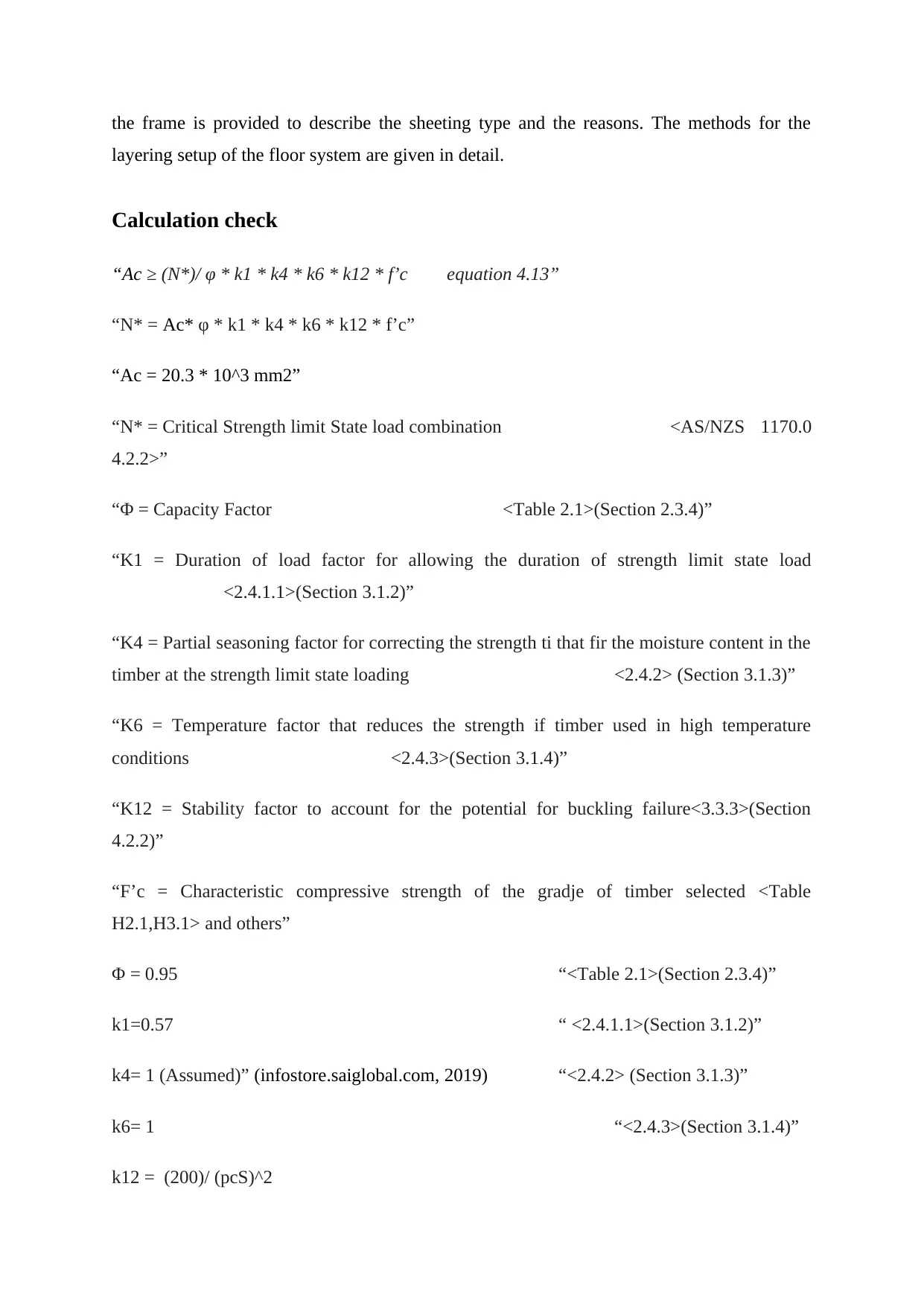
the frame is provided to describe the sheeting type and the reasons. The methods for the
layering setup of the floor system are given in detail.
Calculation check
“Ac ≥ (N*)/ φ * k1 * k4 * k6 * k12 * f’c equation 4.13”
“N* = Ac* φ * k1 * k4 * k6 * k12 * f’c”
“Ac = 20.3 * 10^3 mm2”
“N* = Critical Strength limit State load combination <AS/NZS 1170.0
4.2.2>”
“Φ = Capacity Factor <Table 2.1>(Section 2.3.4)”
“K1 = Duration of load factor for allowing the duration of strength limit state load
<2.4.1.1>(Section 3.1.2)”
“K4 = Partial seasoning factor for correcting the strength ti that fir the moisture content in the
timber at the strength limit state loading <2.4.2> (Section 3.1.3)”
“K6 = Temperature factor that reduces the strength if timber used in high temperature
conditions <2.4.3>(Section 3.1.4)”
“K12 = Stability factor to account for the potential for buckling failure<3.3.3>(Section
4.2.2)”
“F’c = Characteristic compressive strength of the gradje of timber selected <Table
H2.1,H3.1> and others”
Φ = 0.95 “<Table 2.1>(Section 2.3.4)”
k1=0.57 “ <2.4.1.1>(Section 3.1.2)”
k4= 1 (Assumed)” (infostore.saiglobal.com, 2019) “<2.4.2> (Section 3.1.3)”
k6= 1 “<2.4.3>(Section 3.1.4)”
k12 = (200)/ (pcS)^2
layering setup of the floor system are given in detail.
Calculation check
“Ac ≥ (N*)/ φ * k1 * k4 * k6 * k12 * f’c equation 4.13”
“N* = Ac* φ * k1 * k4 * k6 * k12 * f’c”
“Ac = 20.3 * 10^3 mm2”
“N* = Critical Strength limit State load combination <AS/NZS 1170.0
4.2.2>”
“Φ = Capacity Factor <Table 2.1>(Section 2.3.4)”
“K1 = Duration of load factor for allowing the duration of strength limit state load
<2.4.1.1>(Section 3.1.2)”
“K4 = Partial seasoning factor for correcting the strength ti that fir the moisture content in the
timber at the strength limit state loading <2.4.2> (Section 3.1.3)”
“K6 = Temperature factor that reduces the strength if timber used in high temperature
conditions <2.4.3>(Section 3.1.4)”
“K12 = Stability factor to account for the potential for buckling failure<3.3.3>(Section
4.2.2)”
“F’c = Characteristic compressive strength of the gradje of timber selected <Table
H2.1,H3.1> and others”
Φ = 0.95 “<Table 2.1>(Section 2.3.4)”
k1=0.57 “ <2.4.1.1>(Section 3.1.2)”
k4= 1 (Assumed)” (infostore.saiglobal.com, 2019) “<2.4.2> (Section 3.1.3)”
k6= 1 “<2.4.3>(Section 3.1.4)”
k12 = (200)/ (pcS)^2
Paraphrase This Document
Need a fresh take? Get an instant paraphrase of this document with our AI Paraphraser
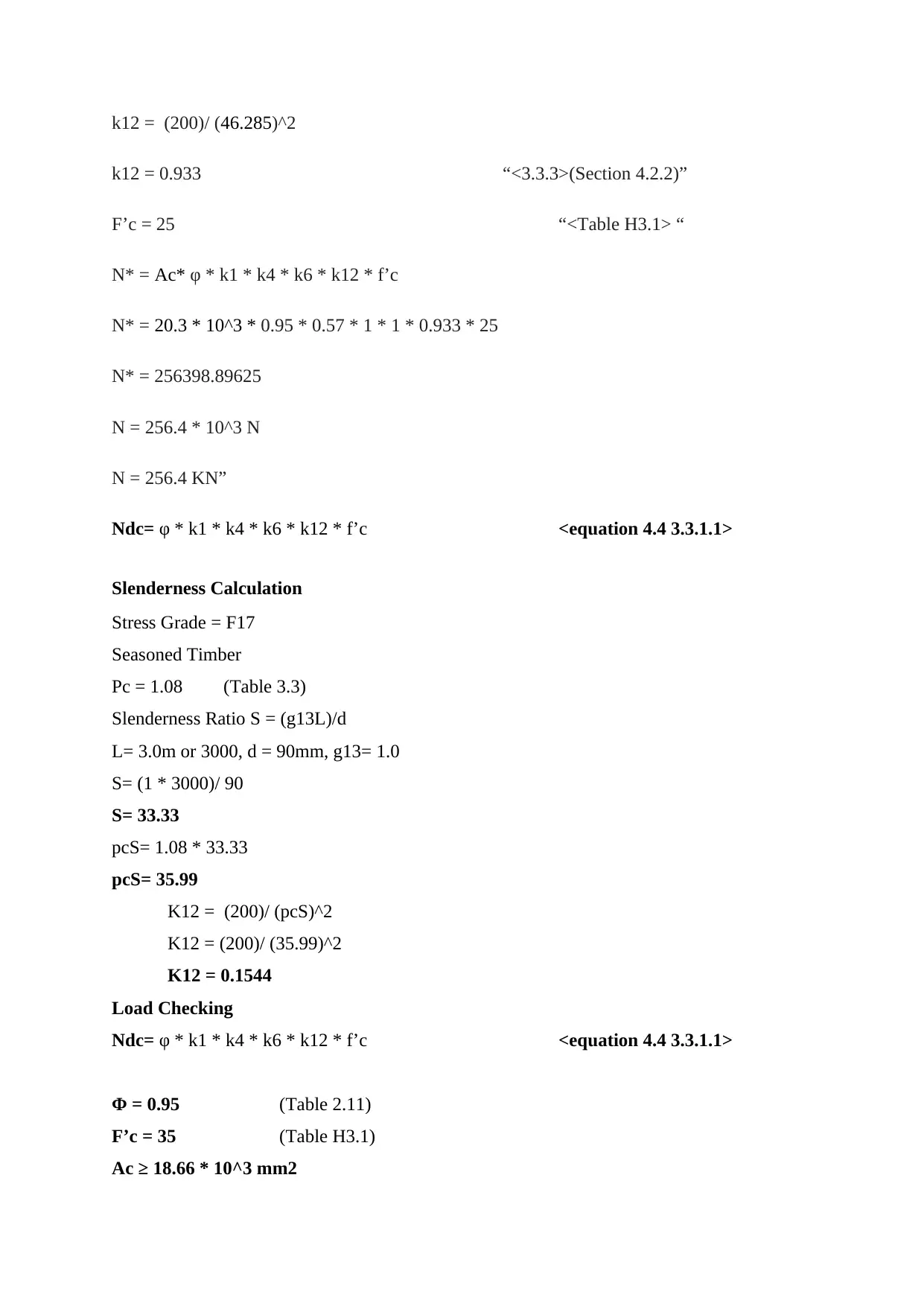
k12 = (200)/ (46.285)^2
k12 = 0.933 “<3.3.3>(Section 4.2.2)”
F’c = 25 “<Table H3.1> “
N* = Ac* φ * k1 * k4 * k6 * k12 * f’c
N* = 20.3 * 10^3 * 0.95 * 0.57 * 1 * 1 * 0.933 * 25
N* = 256398.89625
N = 256.4 * 10^3 N
N = 256.4 KN”
Ndc= φ * k1 * k4 * k6 * k12 * f’c <equation 4.4 3.3.1.1>
Slenderness Calculation
Stress Grade = F17
Seasoned Timber
Pc = 1.08 (Table 3.3)
Slenderness Ratio S = (g13L)/d
L= 3.0m or 3000, d = 90mm, g13= 1.0
S= (1 * 3000)/ 90
S= 33.33
pcS= 1.08 * 33.33
pcS= 35.99
K12 = (200)/ (pcS)^2
K12 = (200)/ (35.99)^2
K12 = 0.1544
Load Checking
Ndc= φ * k1 * k4 * k6 * k12 * f’c <equation 4.4 3.3.1.1>
Φ = 0.95 (Table 2.11)
F’c = 35 (Table H3.1)
Ac ≥ 18.66 * 10^3 mm2
k12 = 0.933 “<3.3.3>(Section 4.2.2)”
F’c = 25 “<Table H3.1> “
N* = Ac* φ * k1 * k4 * k6 * k12 * f’c
N* = 20.3 * 10^3 * 0.95 * 0.57 * 1 * 1 * 0.933 * 25
N* = 256398.89625
N = 256.4 * 10^3 N
N = 256.4 KN”
Ndc= φ * k1 * k4 * k6 * k12 * f’c <equation 4.4 3.3.1.1>
Slenderness Calculation
Stress Grade = F17
Seasoned Timber
Pc = 1.08 (Table 3.3)
Slenderness Ratio S = (g13L)/d
L= 3.0m or 3000, d = 90mm, g13= 1.0
S= (1 * 3000)/ 90
S= 33.33
pcS= 1.08 * 33.33
pcS= 35.99
K12 = (200)/ (pcS)^2
K12 = (200)/ (35.99)^2
K12 = 0.1544
Load Checking
Ndc= φ * k1 * k4 * k6 * k12 * f’c <equation 4.4 3.3.1.1>
Φ = 0.95 (Table 2.11)
F’c = 35 (Table H3.1)
Ac ≥ 18.66 * 10^3 mm2
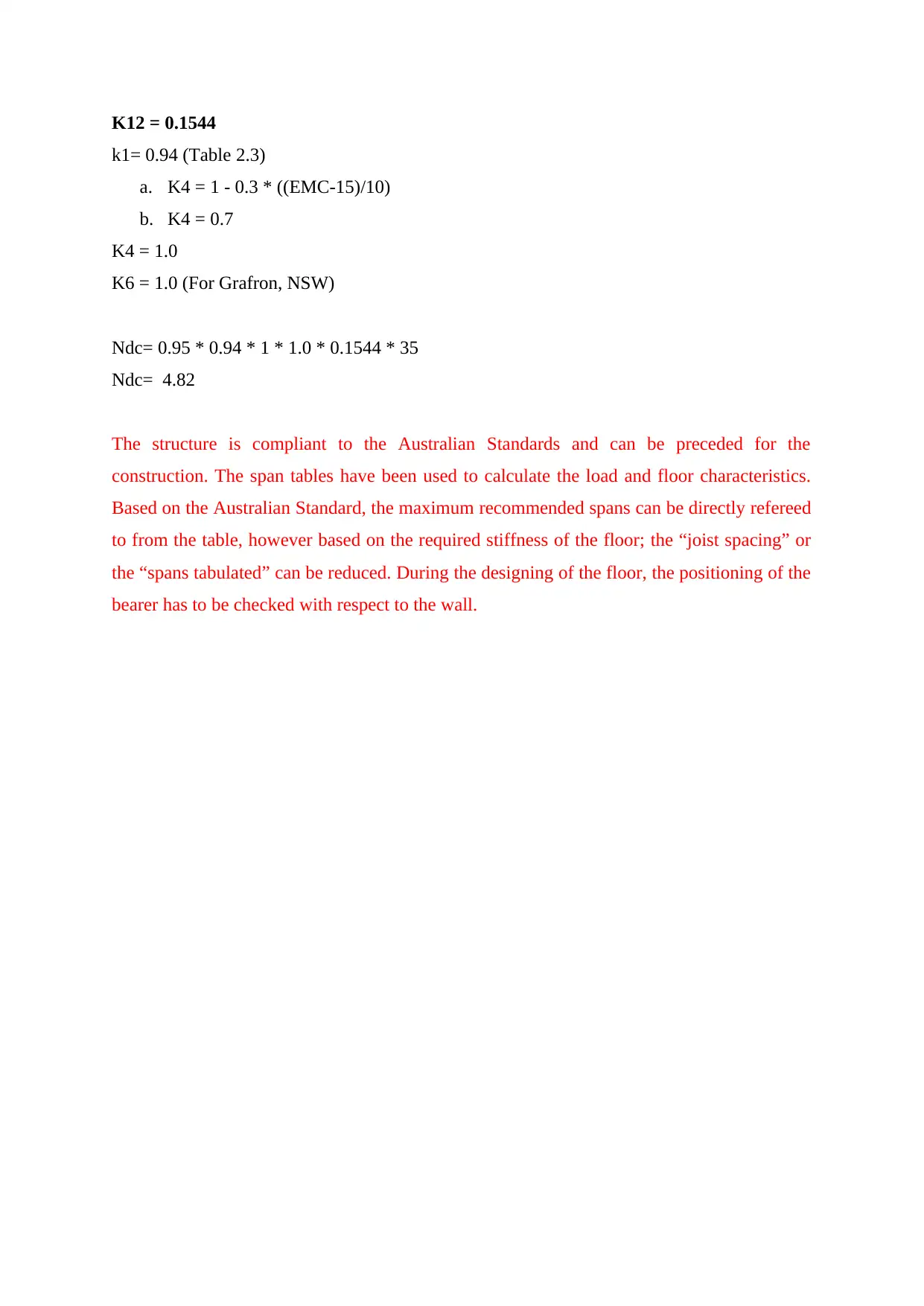
K12 = 0.1544
k1= 0.94 (Table 2.3)
a. K4 = 1 - 0.3 * ((EMC-15)/10)
b. K4 = 0.7
K4 = 1.0
K6 = 1.0 (For Grafron, NSW)
Ndc= 0.95 * 0.94 * 1 * 1.0 * 0.1544 * 35
Ndc= 4.82
The structure is compliant to the Australian Standards and can be preceded for the
construction. The span tables have been used to calculate the load and floor characteristics.
Based on the Australian Standard, the maximum recommended spans can be directly refereed
to from the table, however based on the required stiffness of the floor; the “joist spacing” or
the “spans tabulated” can be reduced. During the designing of the floor, the positioning of the
bearer has to be checked with respect to the wall.
k1= 0.94 (Table 2.3)
a. K4 = 1 - 0.3 * ((EMC-15)/10)
b. K4 = 0.7
K4 = 1.0
K6 = 1.0 (For Grafron, NSW)
Ndc= 0.95 * 0.94 * 1 * 1.0 * 0.1544 * 35
Ndc= 4.82
The structure is compliant to the Australian Standards and can be preceded for the
construction. The span tables have been used to calculate the load and floor characteristics.
Based on the Australian Standard, the maximum recommended spans can be directly refereed
to from the table, however based on the required stiffness of the floor; the “joist spacing” or
the “spans tabulated” can be reduced. During the designing of the floor, the positioning of the
bearer has to be checked with respect to the wall.
⊘ This is a preview!⊘
Do you want full access?
Subscribe today to unlock all pages.

Trusted by 1+ million students worldwide
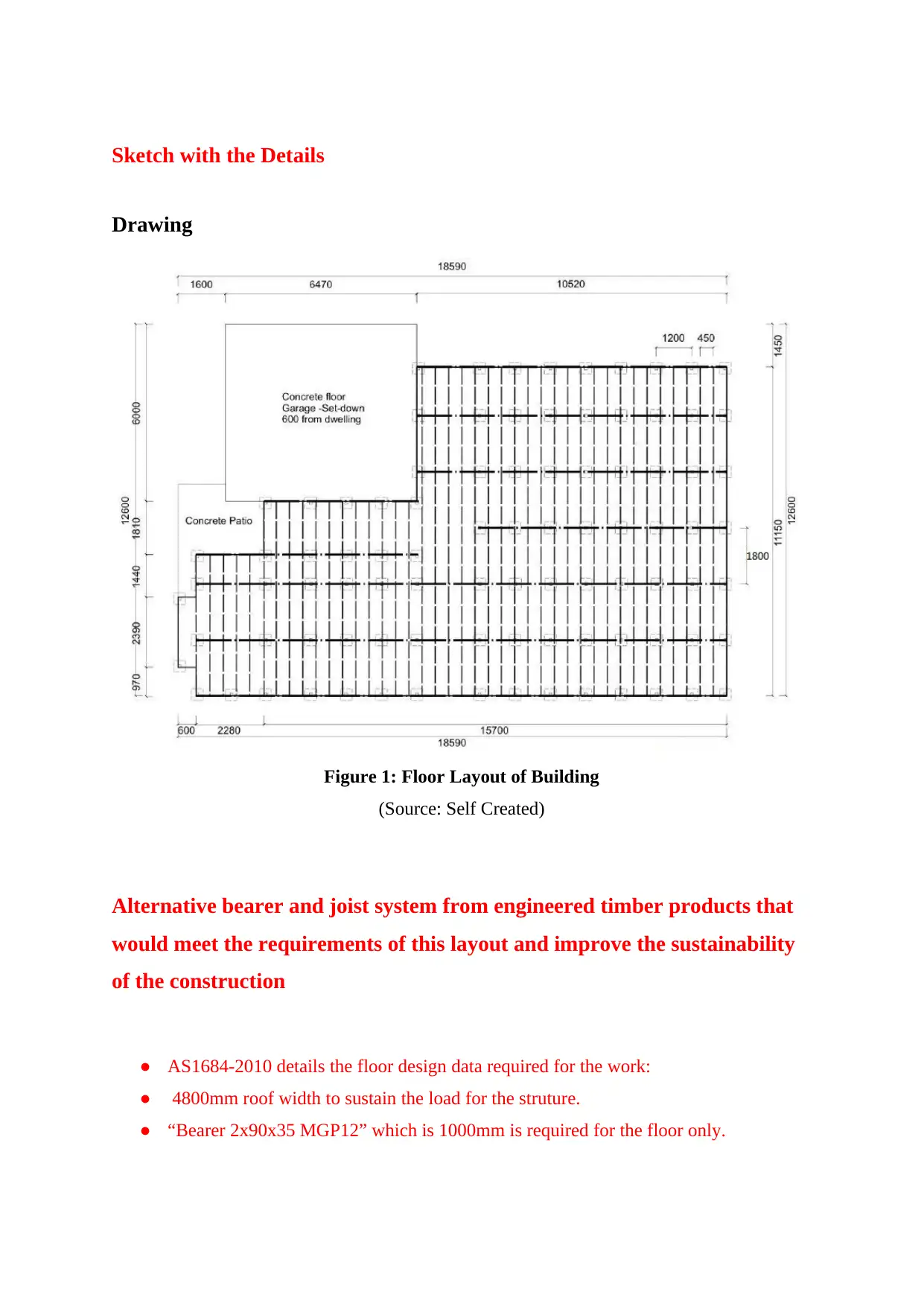
Sketch with the Details
Drawing
Figure 1: Floor Layout of Building
(Source: Self Created)
Alternative bearer and joist system from engineered timber products that
would meet the requirements of this layout and improve the sustainability
of the construction
● AS1684-2010 details the floor design data required for the work:
● 4800mm roof width to sustain the load for the struture.
● “Bearer 2x90x35 MGP12” which is 1000mm is required for the floor only.
Drawing
Figure 1: Floor Layout of Building
(Source: Self Created)
Alternative bearer and joist system from engineered timber products that
would meet the requirements of this layout and improve the sustainability
of the construction
● AS1684-2010 details the floor design data required for the work:
● 4800mm roof width to sustain the load for the struture.
● “Bearer 2x90x35 MGP12” which is 1000mm is required for the floor only.
Paraphrase This Document
Need a fresh take? Get an instant paraphrase of this document with our AI Paraphraser
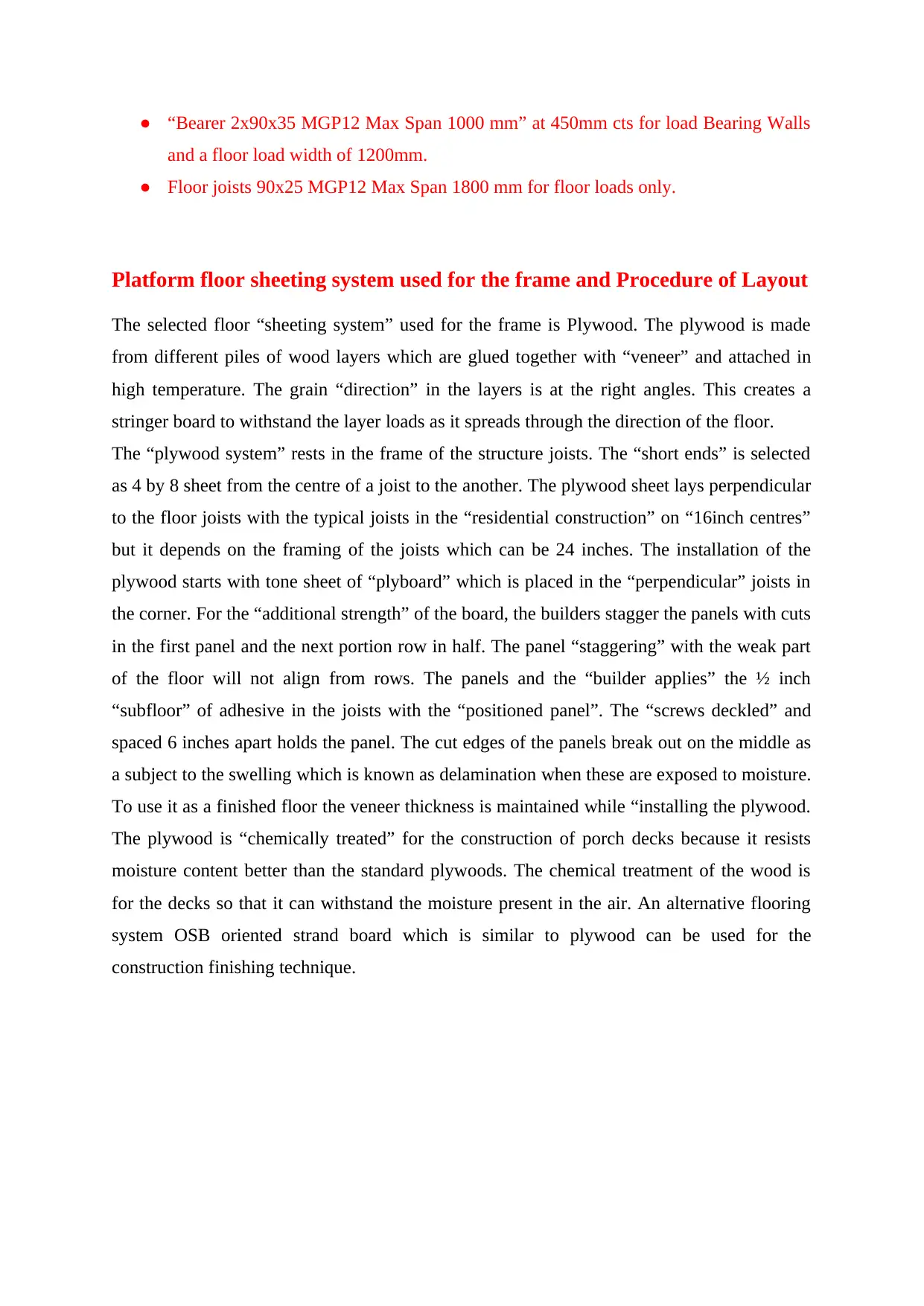
● “Bearer 2x90x35 MGP12 Max Span 1000 mm” at 450mm cts for load Bearing Walls
and a floor load width of 1200mm.
● Floor joists 90x25 MGP12 Max Span 1800 mm for floor loads only.
Platform floor sheeting system used for the frame and Procedure of Layout
The selected floor “sheeting system” used for the frame is Plywood. The plywood is made
from different piles of wood layers which are glued together with “veneer” and attached in
high temperature. The grain “direction” in the layers is at the right angles. This creates a
stringer board to withstand the layer loads as it spreads through the direction of the floor.
The “plywood system” rests in the frame of the structure joists. The “short ends” is selected
as 4 by 8 sheet from the centre of a joist to the another. The plywood sheet lays perpendicular
to the floor joists with the typical joists in the “residential construction” on “16inch centres”
but it depends on the framing of the joists which can be 24 inches. The installation of the
plywood starts with tone sheet of “plyboard” which is placed in the “perpendicular” joists in
the corner. For the “additional strength” of the board, the builders stagger the panels with cuts
in the first panel and the next portion row in half. The panel “staggering” with the weak part
of the floor will not align from rows. The panels and the “builder applies” the ½ inch
“subfloor” of adhesive in the joists with the “positioned panel”. The “screws deckled” and
spaced 6 inches apart holds the panel. The cut edges of the panels break out on the middle as
a subject to the swelling which is known as delamination when these are exposed to moisture.
To use it as a finished floor the veneer thickness is maintained while “installing the plywood.
The plywood is “chemically treated” for the construction of porch decks because it resists
moisture content better than the standard plywoods. The chemical treatment of the wood is
for the decks so that it can withstand the moisture present in the air. An alternative flooring
system OSB oriented strand board which is similar to plywood can be used for the
construction finishing technique.
and a floor load width of 1200mm.
● Floor joists 90x25 MGP12 Max Span 1800 mm for floor loads only.
Platform floor sheeting system used for the frame and Procedure of Layout
The selected floor “sheeting system” used for the frame is Plywood. The plywood is made
from different piles of wood layers which are glued together with “veneer” and attached in
high temperature. The grain “direction” in the layers is at the right angles. This creates a
stringer board to withstand the layer loads as it spreads through the direction of the floor.
The “plywood system” rests in the frame of the structure joists. The “short ends” is selected
as 4 by 8 sheet from the centre of a joist to the another. The plywood sheet lays perpendicular
to the floor joists with the typical joists in the “residential construction” on “16inch centres”
but it depends on the framing of the joists which can be 24 inches. The installation of the
plywood starts with tone sheet of “plyboard” which is placed in the “perpendicular” joists in
the corner. For the “additional strength” of the board, the builders stagger the panels with cuts
in the first panel and the next portion row in half. The panel “staggering” with the weak part
of the floor will not align from rows. The panels and the “builder applies” the ½ inch
“subfloor” of adhesive in the joists with the “positioned panel”. The “screws deckled” and
spaced 6 inches apart holds the panel. The cut edges of the panels break out on the middle as
a subject to the swelling which is known as delamination when these are exposed to moisture.
To use it as a finished floor the veneer thickness is maintained while “installing the plywood.
The plywood is “chemically treated” for the construction of porch decks because it resists
moisture content better than the standard plywoods. The chemical treatment of the wood is
for the decks so that it can withstand the moisture present in the air. An alternative flooring
system OSB oriented strand board which is similar to plywood can be used for the
construction finishing technique.

⊘ This is a preview!⊘
Do you want full access?
Subscribe today to unlock all pages.

Trusted by 1+ million students worldwide
1 out of 9
Your All-in-One AI-Powered Toolkit for Academic Success.
+13062052269
info@desklib.com
Available 24*7 on WhatsApp / Email
![[object Object]](/_next/static/media/star-bottom.7253800d.svg)
Unlock your academic potential
Copyright © 2020–2025 A2Z Services. All Rights Reserved. Developed and managed by ZUCOL.


